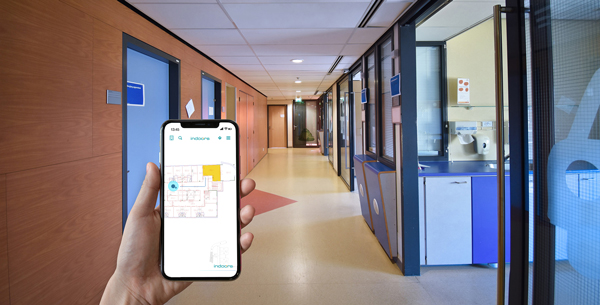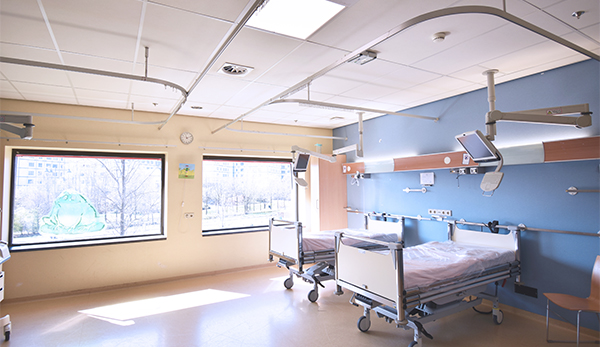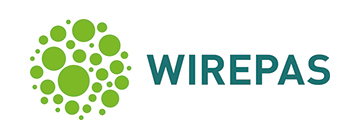UMC Utrecht uses tags and decentralised mesh network to enable on-demand dispatched equipment
Not knowing where things are, can be inconvenient at best. In hospitals, not having wheelchairs, beds and infusion pumps available at the right time can impede the required daily care. But as patients are frequently on the move, says Liam van Koert, keeping track of hospital assets proves challenging in practice.
University Medical Center Utrecht initiated the pilot project UFOund to tackle this problem in a user experience centre. They first tagged their equipment and connected it to a mesh network. Then they gave nurses and technical staff real-time information on the whereabouts of equipment. Better yet, they can ‘beep’ whatever they need with the push of a button.
It is not often that an opportunity, such as the one at the Children’s Hospital in Utrecht, presents itself. But as the ward, which owes its name to the ample, cheerfully painted green frogs on the walls, is due for some serious renovation work, UFOund’s Project Manager, Wiko Lamain and Clinical Informatician, Thijs Dijkgraaf have turned the Second floor into a playground of their own. Having installed network ‘anchors’ and tracking tags, they can freely experiment with moving beds and pumps around and check various set-ups for accuracy and robustness, without interfering with daily hospital logistics.
They have also equipped a dedicated information centre which people from all over the world can visit to see what they are up to. Hospital logistics are complicated everywhere. And UMC’s novel IoT-based approach towards tracking & tracing, amongst other things, has received the medical community’s attention.
Processes first
“UFOund delivers the fundamentals for the MAtriX project which aims at improving the quality of care provided in UMC Utrecht for both patients and staff” by improving the availability and employability of medical equipment, explains Lamain, who has been connecting lots of possible IoT dots for UMC for almost a year now.
“One of the things we try to achieve with the project is to better align workflow processes with the standard equipment used by our staff to nurse patients on a daily basis. We do so by first looking at our current processes, and then seek ways to improve them. Secondly, we investigate new technological opportunities that have arisen to support them.” According to Lamain – like in many other fields – hospitals nowadays face having to provide higher quality care for less money, with fewer people.
Black hole
In the search for bottlenecks to eliminate, UMC Utrecht found that not having immediate access to standard equipment was an unnecessary hindrance that could in theory ‘quite easily’ be dealt with. Not knowing where beds, wheelchairs or infusion pumps are when you need them? It happens more often than one might think.
A wheelchair might be displaced or borrowed by a colleague for an emergency. Maybe a bed is broken, and it has been sent to the technical staff for repair. Whatever the reason, too much valuable time is wasted in the searches that inevitably follow.
Lamain comments, “When delving deep in the whereabouts of hospital equipment, you’ll find that you might think you know where things are, but in many cases you actually don’t. Now you could – for improved tracking and tracing – introduce a system where all equipment is dispatched from a central location. Here you can check the equipment’s technical status, plan maintenance and keep stock of the inventory in general. But you don’t want nurses to walk a mile and a half every time they need something. They have patients to take care of.
“Wouldn’t it be much easier if you could see where the closest available bed is in real-time on your phone? Or even better: have one delivered to you with the push of a button? The solution we are researching within project UFOund aims to have the best of both worlds, using one or multiple IoT technologies as the enabler,” says Lamain.
Improved patient experience
There is, according to Lamain, a lot to be gained by using such a system, and not just from a logistics perspective. Patients will experience higher quality care due to more personal hands-on time from nurses and smoother transitions from one ward to another. “One of the bottlenecks when moving patients is getting them hooked up to the right infusion pump. Every department has its own type, with its own settings. This results in patients having to switch pumps multiple times when going in and coming out of surgery. Using IoT for getting the right pumps at the right place at the right time will help to significantly improve the patient experience. And who knows what future IoT developments will bring in terms of negating settings and functionality, so that switching pumps can be a thing of the past altogether.”

IoT playground
Finding the right IoT technology for project UFOund was no easy feat. There are ample different technologies to choose from, each with their own plusses and minuses. You can use active or passive RFID tags, barcodes, QR codes, and vision, to name just a few.
In terms of visibility, how accurate are these different methods? You can place scanners in doorways, so you know where things are at room level. You could also add cameras with image recognition software to know the exact position, but alongside the privacy issues, you would of course be limited to the line of sight.
When considering the price tag, passive RFID might seem the more affordable option, but the reading equipment is expensive. A better method could be using active – battery-powered – tags that send a signal to a mesh network. By measuring the distance between the tag and a minimum of two nodes, you can calculate the exact position using triangulation. But how precise is exact? And do the high electromagnetic frequencies produced by the tags interfere with hospital equipment? How often should I send a position signal to the network for the logistic applications to run smoothly? How much data does this generate? How do I handle this? And what does this mean for the battery life of my tags?
These are just a few questions that Lamain and his team sought answers to. And they fortunately had an entire ward to use as an IoT playground to come up with some promising results.
Vast ecosystem
One of these results is a robust mesh network that uses Wirepas for communication between the network nodes. Originally researched by Tampere University of Technology in Finland, this network technology is self-organising and thus always up and running. Also, it uses very little energy to do so.
“This mesh network is great for a wide variety of applications, hospital logistics being one of them,” Dennis van Doorn, marketing manager, Wireless Solutions at Fujitsu elaborates, while checking if everything is online. “Different nodes – used in this set-up include the mobile tags, sensors (environment monitoring such as temperature and C0₂, and fridge temperature monitoring) but also fixed anchor nodes – automatically connect with one another. Choosing the best communication channel, required signal strength and the best route for the data is a unique feature of this technology.
“The main advantage is that the resulting mesh network is highly robust, as multiple routes can be taken. It is also a far more efficient way to communicate, since the dataflow can be evenly distributed among the different nodes, providing maximum band width and minimal power consumption. It makes the technology eminently suitable for complex environments such as hospitals.” Van Doorn adds that it, of course, helps tremendously to work with an experienced network of eco-system partners, all experts in their own respected fields. “Very much like the Wirepas network itself, a seamless flow of information between partners has enabled us to address all basic requirements as well as add-on functionalities that have emerged during the trial phase of the UFOund and MAtriX project.”
Smart lighting and switches
One of the challenges in mesh networking can be the large number of nodes that need to be installed and the power requirements that come along with it. However, as Sytze Terpstra from smart lighting provider Ingy explains, in the case of the UFOund project another novel idea provided a scalable solution that would not only address power requirements but would also fully support future IoT applications.
Terpstra says: “We have configured all the Interlight smart LED lighting fixtures as anchor nodes. These are the fixed ceiling nodes that together form the mesh network, through which the battery powered mobile tags communicate their positions. Not only is this solution no more expensive than the normal LED lighting upgrade that was planned anyway to save on energy costs, it also takes care of all the power restrictions. Being mains-powered the lighting provides a very low latency network which in turn enables the possibility to easily extend the amount of IoT applications that run on top of it.”
One of these applications is the integration of energy-harvesting wireless switches from EnOcean. The beauty of these is that no power is required at all. The energy induced by pressing the button is enough to switch the light or make a ‘call’ for assistance, a bed, or whatever function you want to use it for. And, as an added bonus, the lighting offers extra functionality such as daylight compensation, smart grouping and lighting plans based on presence or personal preferences. The presence sensor provides occupancy data which is processed and displayed in the GOOEE portal, which also catches the environmental sensor data such as air quality.
Tracking platform
Another contributor that eagerly pushes around beds and pumps alike, while tracking them with his laptop via several especially developed applications, is Christian Sveistrup from Systematic. The Denmark-based firm that he works for specialises in decision-making software and has developed a comprehensive eHealth suite that forms the basis of a custom-made and role-based tracking solution for UMC Utrecht.
Sveistrup explains, “We use the longitude and latitude data we receive from the Wirepas tags for several applications. One is a viewer that visualises all the connected equipment on top of a floorplan. We also include additional information on the assets. Based on one’s role, the user can thus see where the available beds or pumps that need servicing are located. General information can be shown on large screens, user-specific information on a smartphone or tablet. We can also add tasks and alarms in the form of notifications.
“Is there a minimum number of pumps that need to be within a specified area, or is a certain piece of equipment not allowed to leave the ward? An alarm informs the right person on what is happening. Geo-based task lists are also possible, which are particularly convenient for service personnel who usually have multiple buildings to cover and can now far more efficiently gain insights into outstanding jobs nearby. These task lists are of course not set in stone and can be easily adjusted for the nightshift when less people usually need to cover more ground. And, last but not least,” says Sveistrup, “there is the possibility to use historical data to further optimise the flow of assets. Just like in a heatmap, you can precisely visualise if, and where, ‘congestion’ has occurred, which is to be expected in a storage room, but preferably not in a hallway.”
Indoor navigation
Guiding patients and staff is another significant challenge in large hospitals, such as the UMC Utrecht. As navigation and wayfinding are currently offered through photo-based wayfinding, in this project other more dynamic methods have been introduced using the beaconing functionality within the Wirepas Mesh.
Nodes are able to transmit standard Bluetooth beacon messages, which are used in Esri’s ArcGIS Indoors solution for indoor mapping and navigation. The ArcGIS Indoors mobile application offers state of the art bluedot indoor positioning, wayfinding and turn-by-turn navigation. This enables the user to get accurate positioning in real-time on their mobile phone, find points of interest and people and navigate to them.
Data-driven future
Taking it one step further, Systematic has also developed tools to optimise the patient flow. Here, besides the availability of assets, they also take into account elements like health and patient safety. Sveistrup: “This kind of optimisation involves complex data science that goes beyond your every-day statistical analysis. But when collaborating with some hospitals and R&D facilities in Denmark, it is amazing what you can achieve with hospital IoT. This, of course, lies way beyond the scope of project UFOund, but they do now have technology available that enables these kinds of use cases in the future.”
As if to underline this, just at that moment a doctor from two floors down walks in to have a playground peek. “You’re experimenting with asset tracking? Perfect! Could you also add tags to random phones, and track those?” It turns out he is looking at ways to improve the response of nurses to medical alarms and considering silent alarms on phones rather than the ‘beeping’ of devices. “Our open ward will be split into more private rooms, but by using walls instead of curtains, it’s harder to hear medical alarms going off. Role-based assignment of alarms via mobile phones might be a viable alternative. To ensure this won’t negatively impact our response times but rather improve them, we want to anonymously study the movement patterns of nurses.”
Wirepas’ eco-system partners are also working on this request, Dennis van Doorn explains, “With such an eco-system of very skilled partners we are able to cover a broad range of projects. By composing IoT components with the ability to operate together we can cover nearly any request.”
Whether or not IoT projects, such as UFOund or the silent medical alarm study, will see a UMC wide roll-out is up to the board to decide. Lamain’s playground findings will be up for review in the second half of this year.
The author is Liam van Koert.











